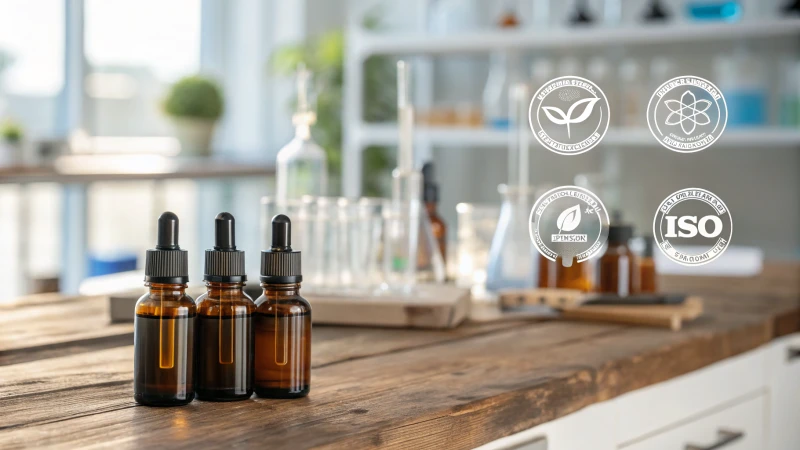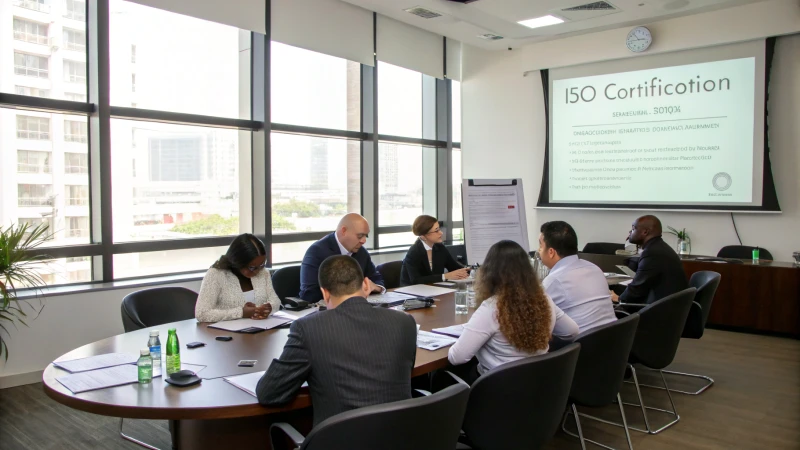
Imagine confidently sourcing glass dropper bottles, knowing they’re top-notch and meet global standards.
The ISO certification process for glass dropper bottles involves a series of essential steps: supplier audits, pre-certification setup, internal quality control and testing, an external audit by a certified body, and continuous compliance. These steps ensure the bottles meet global safety, quality, and environmental standards, benefitting both producers and consumers.
Navigating the ISO certification landscape might seem daunting at first, but understanding each step can make the journey smoother. By delving deeper into these processes, I discovered not only the technical requirements but also the profound sense of security and trust it brings to my business relationships. Let’s break down what it truly means to achieve and uphold these certifications, ensuring my products stand out in quality and reliability.
ISO certification requires external audits for glass bottles.True
An external audit by a certified body is part of the ISO process.
Supplier audits are optional in ISO certification for glass bottles.False
Supplier audits are a key step in the ISO certification process.
What Are the Key ISO Standards Relevant to Glass Dropper Bottles?
When I first dipped my toes into the world of glass dropper bottles, the sea of ISO standards felt overwhelming. But understanding these standards is essential for ensuring the quality and safety of the products we rely on every day.
The key ISO standards for glass dropper bottles are ISO 9001 for quality management, ISO 14001 for environmental responsibility, and ISO 22716 for cosmetic manufacturing practices. These standards ensure the products we use are safe, reliable, and environmentally friendly.

Understanding the Core ISO Standards
When I embarked on my journey with glass dropper bottles, I realized just how pivotal ISO standards are in maintaining product integrity across industries. Let me break down the most relevant ones for you:
-
ISO 9001: Quality Management System
I remember the first time I implemented ISO 9001—it was like unlocking a new level of customer satisfaction. This standard ensures that products consistently meet customer and regulatory requirements through rigorous quality checks and process improvements. -
ISO 14001: Environmental Management System
With a growing emphasis on sustainability, ISO 14001 has become crucial. It guides companies in managing their environmental responsibilities effectively, something I’ve found increasingly important as we push towards sustainable packaging. -
ISO 22716: Good Manufacturing Practices (GMP) for Cosmetics
In the cosmetic industry, consistency is key. This standard ensures that products are manufactured according to strict quality guidelines, covering documentation, hygiene, and testing. Implementing it was a game-changer for maintaining high standards in production. -
ISO 13485: Medical Devices
Even though this standard is primarily for medical devices, it’s critical when dropper bottles are used for medicinal purposes. It ensures safety and performance requirements are met—something that gives peace of mind when health is on the line.
| Standard | Focus Area |
|---|---|
| ISO 9001 | Quality management |
| ISO 14001 | Environmental management |
| ISO 22716 | Cosmetic manufacturing practices |
| ISO 13485 | Medical device safety |
Importance of Supplier Certification
Selecting suppliers who are ISO certified has been vital in my experience. Certified suppliers adhere to international best practices, ensuring product consistency and safety. This helps in minimizing risks related to product recalls1 and defects.
Navigating the Certification Process
The certification process might seem daunting at first, but understanding it is crucial for compliance:
-
Supplier Audit
Start by auditing your supplier’s current standards. Look for existing quality systems that align with ISO requirements.
-
Material Sourcing
Ensure materials meet ISO sustainability and safety criteria—a critical step given stringent environmental regulations2.
-
Pre-Certification Setup
Document all manufacturing processes and train employees on compliance standards. Fostering a culture of quality is essential.
-
Internal Testing
Establish robust quality control measures like batch testing for defects. Regular tests ensure dropper bottles are safe for their intended use.
-
External Audit and Certification
Engage a third-party certification body for an external audit. Address any non-conformities before receiving official certification.
By understanding these standards and processes, I’ve found that businesses can navigate the complexities of ISO certification3 more effectively. This not only ensures compliance but also enhances product reliability and market competitiveness.
ISO 9001 ensures product quality for glass dropper bottles.True
ISO 9001 focuses on quality management systems, ensuring product consistency.
ISO 22716 is irrelevant to cosmetic manufacturing.False
ISO 22716 provides GMP guidelines essential for cosmetic production.
How Does ISO Certification Benefit B2B Buyers?
When I first discovered the impact of ISO certification on B2B transactions, it was a game-changer for my business strategy.
ISO certification provides B2B buyers with assurance of quality, safety, and compliance from their suppliers. It promotes transparency in the supply chain, reduces risks, and facilitates smooth procurement processes, thereby building trust and reliability.

Ensuring Consistent Quality and Reliability
I remember the relief I felt when I first partnered with an ISO-certified supplier. It was like having a safety net; knowing that they adhered to international standards meant I could breathe easier about the quality of the products I was sourcing. Defects and recalls, which once seemed like an inevitable part of the business, became rare occurrences.
| Benefits | Description |
|---|---|
| Quality Assurance | Products meet rigorous quality standards consistently. |
| Reliability | Suppliers have a track record of reliability and competence. |
Enhancing Supply Chain Transparency
With ISO-certified suppliers, I found a level of transparency that was previously elusive. Every step was documented, every detail accounted for, allowing me to trace product origins with ease. This was not just about meeting standards—it was about having confidence in every single product that passed through my hands.
- Traceability: Ensures each step is documented and monitored.
- Documentation: Provides comprehensive records for audits and compliance checks.
Minimizing Risks and Costs
Choosing ISO-certified suppliers has also been instrumental in reducing unexpected costs and compliance issues. In industries where standards are non-negotiable, like pharmaceuticals, this can mean the difference between success and costly setbacks.
- Risk Reduction: Decreases potential legal and financial liabilities.
- Cost Management: Reduces costs associated with defect management and recalls.
Supporting Efficient Procurement Processes
I’ve noticed that suppliers who are ISO-certified often have more efficient processes. This means fewer disruptions for me and a smoother overall procurement process, allowing me to keep my focus where it truly matters—on growing my business.
- Efficiency: Streamlined processes improve delivery timelines.
- Communication: Clear guidelines lead to better supplier-buyer communication.
Fostering Trust and Reliability
Ultimately, ISO certification has become a cornerstone in building trust with my suppliers. This trust extends all the way to my customers, enhancing my brand’s reputation and customer satisfaction.
- Trust Building: Confidence in supplier capabilities boosts buyer trust.
- Reputation: Association with certified suppliers elevates brand perception.
Understanding these benefits has transformed how I make decisions in my business, ensuring that every choice supports my goals while maintaining compliance and efficiency in the supply chain.
ISO certification ensures consistent product quality.True
ISO standards require suppliers to adhere to strict quality guidelines.
ISO certification increases product recall risks.False
ISO standards minimize defects, reducing the likelihood of recalls.
What Challenges Might Arise During the Certification Process?
Embarking on the certification journey? It can feel like navigating a maze, but understanding potential pitfalls can make all the difference.
The certification process is fraught with challenges like deciphering complex requirements, managing vast documentation, ensuring comprehensive staff training, and tackling surprise audit findings. By planning ahead and fostering open communication with everyone involved, these hurdles can be significantly eased.

Understanding Detailed Requirements
I remember the first time I faced the daunting task of interpreting the intricate details of certification requirements4. It felt like trying to read a novel in a foreign language! Each certification type, like those for quality management systems or environmental criteria, has its own set of standards. Keeping up with frequent updates can be a real headache.
Managing Documentation
Ah, documentation! It’s both a blessing and a curse. I once spent an entire weekend knee-deep in paper trails, trying to ensure every process was logged to perfection. Missing even a single document can cause serious delays or, worse, a failed certification. That’s why implementing a robust document management system became my lifeline.
| Document Type | Purpose |
|---|---|
| Process Manuals | Outline standard operating procedures |
| Audit Reports | Track compliance and identify gaps |
| Training Records | Ensure staff understand responsibilities |
Ensuring Staff Training
Imagine trying to assemble a puzzle without knowing what the picture looks like—that’s what it feels like when staff aren’t properly trained. I’ve learned that regular training sessions and workshops are crucial. They ensure everyone knows their part in maintaining compliance.
Handling Unexpected Audit Findings
Audits can feel like waiting for exam results—nerve-wracking! Sometimes they uncover issues you never anticipated. By conducting regular internal audits, I’ve managed to catch most problems before they become major roadblocks during official inspections.
Communication with Stakeholders
Effective communication isn’t just important; it’s everything. I’ve seen projects falter due to simple miscommunications between teams and external auditors. Setting up clear lines of communication early on has saved me from many headaches, ensuring everyone’s on the same page throughout the certification process.
Decoding certification standards is straightforward.False
Certification standards are complex and frequently updated, making them challenging to decode.
Incomplete documentation can delay certification.True
Missing or incomplete records can hinder the certification process, causing delays.
How can companies ensure ongoing compliance with ISO standards?
Ever wondered how to keep your company consistently aligned with ISO standards? Trust me, it’s all about weaving these practices into the fabric of your daily operations.
Companies can ensure ongoing ISO compliance by conducting regular audits, providing continuous employee training, and fostering a culture of quality improvement. These efforts help align operations with ever-evolving standards and regulations.

Regular Audits and Reviews
Let me take you back to a time when I almost missed the mark on an important audit. It was a turning point. Conducting regular internal and external audits became my non-negotiable strategy. Internal audits help me catch those little hiccups before they snowball, while external audits, performed by accredited bodies, offer an impartial view that keeps everything in check.
Audit Checklist:
| Audit Type | Frequency | Purpose |
|---|---|---|
| Internal | Quarterly | Identify gaps and improve processes |
| External | Annually | Validate compliance with ISO standards |
These audits are more than just checks; they cultivate a culture of transparency5 within my company, which is something I value deeply.
Continuous Employee Training
I remember the first time I realized the power of training. Employees are truly the heart of any compliance strategy. Regular training ensures everyone is up-to-date with the latest ISO standards and industry practices. Whether it’s through workshops, e-learning modules, or interactive seminars, I find it essential to keep my team sharp.
Training Components:
- Introduction to ISO Standards
- Role-specific Procedures
- Continuous Improvement Techniques
Investing in ongoing education6 is like planting seeds for a future harvest of excellence.
Embrace a Culture of Quality Improvement
One of the best things I’ve done is to foster a culture where feedback and innovation are welcome. It’s all about continuous improvement and involves everyone from top to bottom.
- Feedback Loops: Regularly collect and act on employee suggestions.
- Innovation Workshops: Host sessions focused on process innovation and efficiency.
- Performance Metrics: Use data-driven metrics to track improvement over time.
A quality-first mindset7 isn’t just a policy—it’s a way of life here.
Leveraging Technology for Compliance
Incorporating technology has been a game-changer for me. Using digital management systems automates tedious tasks like record-keeping and documentation, making it easier to stick to ISO requirements.
- ISO Management Software: Facilitates document control and audit management.
- Data Analytics Tools: Identifies trends and predicts areas of risk.
Embracing modern technology solutions8 has allowed us to manage compliance more efficiently and stay ahead of changes in ISO standards.
Quarterly internal audits ensure ISO compliance.True
Regular internal audits help identify non-conformities early, maintaining compliance.
Annual external audits are optional for ISO compliance.False
External audits are necessary to validate compliance with ISO standards annually.
Conclusion
The ISO certification process for glass dropper bottles ensures compliance with global safety, quality, and environmental standards through supplier audits, internal testing, and external evaluations by certified bodies.
-
Learn how ISO-certified processes reduce recall risks, safeguarding reputation and finances. ↩
-
Discover how adhering to environmental rules influences material sourcing and production. ↩
-
Understand how certification enhances trust, opening new markets and improving reliability. ↩
-
Discover various ISO certifications and understand their specific requirements to better prepare for your certification journey. ↩
-
Learn how regular audits not only verify compliance but also build trust within an organization. ↩
-
Discover why keeping employees updated on ISO standards is crucial for sustained compliance. ↩
-
Understand the importance of fostering a quality-first approach in ensuring ongoing ISO compliance. ↩
-
Explore how technology can simplify and enhance your company’s ISO compliance efforts. ↩



